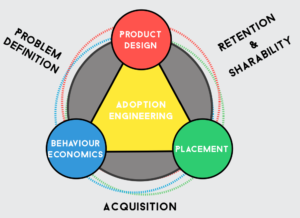The problem
Thousands of apps and startups fail every month! All starting with a noble intention of solving a problem that can change the world for better or create a dent the universe. However, these technologies fail to even collect the “critical mass-1” necessary for their survival. On another hand, however, the end users are getting savvier and much more open to new ideas. People don’t have the same guards up as they used to have, say a decade ago!
So technically, this means faster adoption and thus success! But unfortunately, that’s not the case. Let us delve deeper into the reasons and how adoption engineering can help.
“Your app can address a requirement, solve a problem but still fail to get adopted on counts of user behavior mismatch! ”
Before digging deep lets first define adoption and adoption engineering.
Adoption of an app refers to the app becoming a part of end user’s life and adoption engineering deals with the mechanics of adoption right from the conceptualization of app to activities that lead to retention of users.
In terms of metrics, to entrepreneurs, adoption would mean higher LTV (lifetime value-2) and reduced churn-3. Which directly impacts both the revenues and profitability. Revenues since the customers continue to pay/transact on the app. Profitability because of savings in marketing spends. As the cliche goes – its takes 5X more cost to find a new customer than retain an existing one.
In terms of usability, to end users, it means solving a real problem of life which they may or may not have perceived as a problem before the solution existed, but now have made necessary adaptations to include the application as a part of their life.
Adoption engineering is a multi-disciplinary skill and requires people from various walks of life to collaborate. The diagram below shows the adoption triangle and the graph shows the funnel of adoption.
The three critical factors that drive adoption as are as follows:
1. Behavioral economics: A method of economic analysis that applies psychological insights into human behavior to explain economic decision-making. This branch of economics was used to define factors like purchasing decision in retail. However, today this finds similar application studying behaviors the dictate a product’s adoption. Analytics on app usage provides great insights into user behavior. This section addresses factors such as what leads to a user signing a “contract of trust”, incentivizing for loyalty, instant gratification, hyperbolic discounting, and so on.
2. Product design: This includes user interface design, user experience design, product management, user feedbacks and scenarios management and choice of technology. This section also addresses experience design for first tie users, returning users and invited (or referred) users
3. Placement: The context in which the app is presented and the value a user perceives from it. This covers product branding, marketing, messaging, customer acquisition, copy on the app, choice of platforms and
<Article to be continued>


